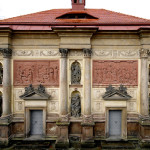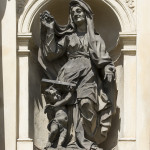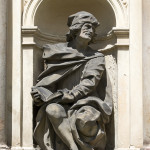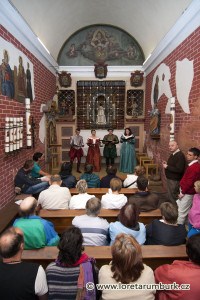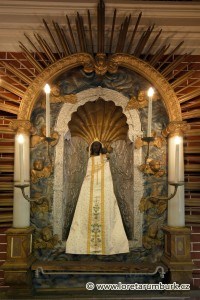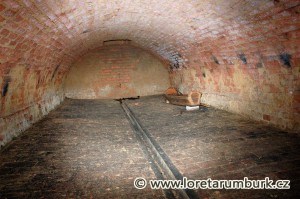Loreto in Rumburk with its stucco and sculptural decoration is among the most valuable Loretos in the Czech Republic. The highly architecturally valued outer arch of the loreto chapel is the baroque copy of the Italian renessaince original. The subject of pilgrim devotion is the Holy House, the house of the Virgin Mary in Nazareth, where the Annunciation of the Saviour’s birth occurred and where Jesus was raised and the holy family once lived.
The Holy House was built from the initiative of the Rumburk dominio owner, Spanish nobleman and diplomat Anton Florian, the prince of Liechtenstein. It was built in the years 1704-1707 based on plans from noteworthy baroque architect Johann Lucas Hildebrandt from Vienna. The impulse for the construction was prince Anton’s personal visit to the pilgrimage location in loreto by Ancona (Italy). The Rumburk Loreto was consecrated on 15. 9. 1707.
The Outer Walls Decoration
Similar to the original Santa Casa in Italian Loreto, the Rumburk Holy House is partially surrounded by an inner corridor to which the lavishly decorated outer coat is connected. The outer decoration of Loreto chapel was finished in 1709. The author and the motives of the original stucco decoration of the Holy House are unknown. It is suggested that scenes from the life of Virgin Mary and the Loreto legend about the Holy House transfer by the angels from Nazareth to Loreto were repeated there. The existing stucco reliefs were created by academic painter Johann Aichinger from Liberec in the years 1899 -1908. The last of ther restoration was during 1985-1989.
The sculptor of the two sandstone statues of Sibyl and prophets is Franz Biener (1682-1742). Biener’s statues in the matter of quality exceed the statues of all other Czech Loreto chapels. Biener was also the creator of all 16 statues of Jesus’ relatives which were originally located on the roof of Loreto chapel. The Rumburk Loreto was the only Holy House in the world that was decorated in this way. After 1808 the roof was changed from flat to hip and nine surviving statues were replaced to balustrade in front of the entrance to the Loreto building.
The Holy House Interior
The simple and not overly decorated inner area of the Loreto chapel is the intentional opposite of the magnificance of the outer decoration. The chapel is devided by a wooden altar partition. The wall paintings portray the scenes from life of the Virgin Mary. Fragments of the decoration remind us of a legend stating that in the votive candle in the Holy House in Italian Loreto, gun powder was placed which exploded upon ignition and destroyed the chapel walls. The places with the Virgin Mary motives remained miraculously untouched. The currect non-authentic status of the interior of the Holy House was influenced by restoration work from the 1980s.
The Black Madonna of Loreto
The subject of pilgim devotion is next to the Holy House, as well as the statue of Black Madonna. The statue was carved from the iniciative of the prince Anton Florian of Liechtenstein after his visit to Loreto in Italy. Three years later, the statue was blessed by Pope Innocent XII. In 1703, the statue, from lime tree wood, was transported to Rumburk. The respect to the Virgin Mary was connected with roughly thirty miraculous healings that were recorded in the loreto memory book by the end of the 19th century.





